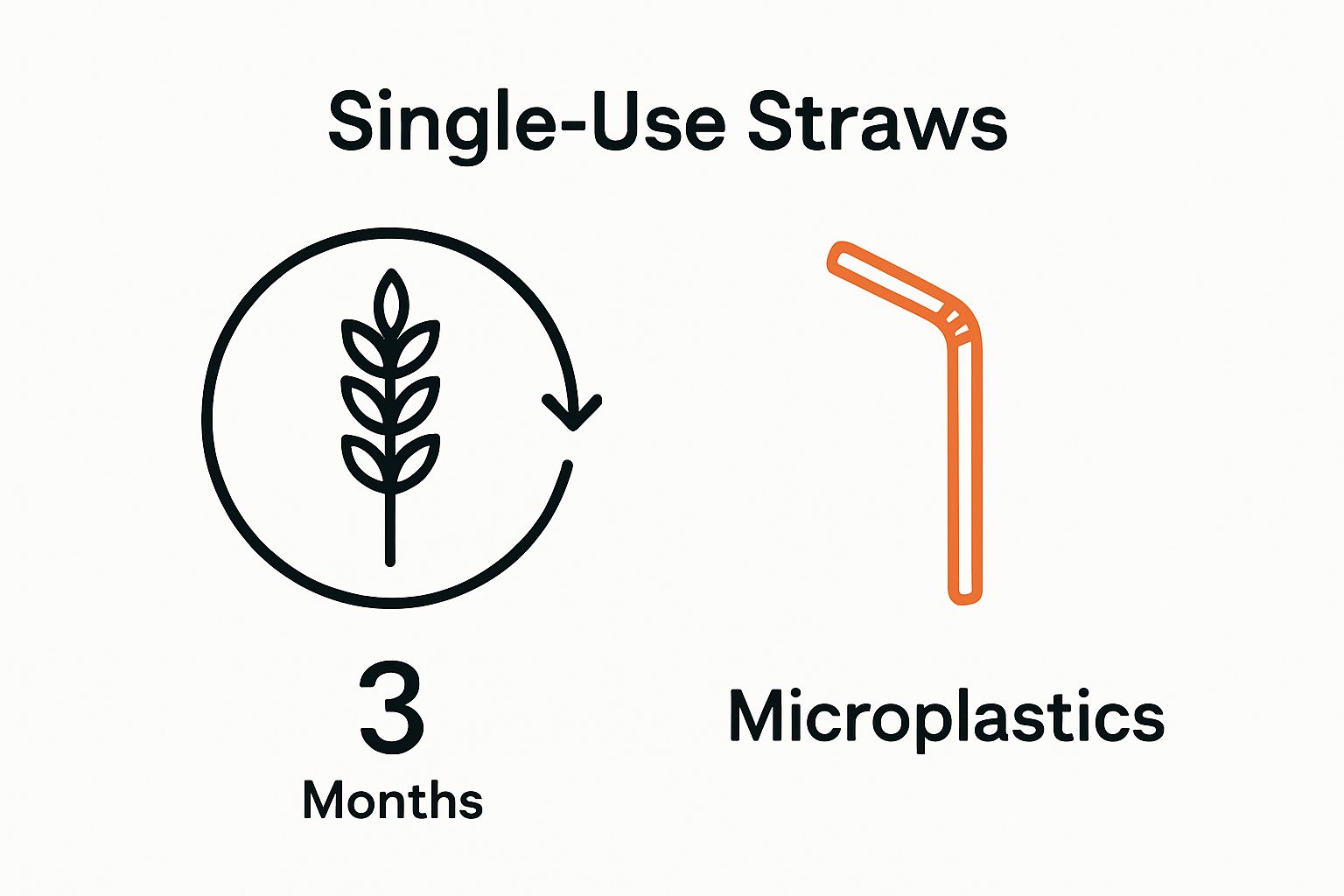Understanding Biodegradable Wheat Straw for Sustainable Choices

Plastic waste is overwhelming landfills and oceans and it can stick around for hundreds of years. Yet a single harvest of wheat can deliver a surprise solution. Biodegradable wheat straw can decompose in as little as 180 days, turning agricultural leftovers into products that disappear as easily as they appear.
Table of Contents
- What Is Biodegradable Wheat Straw?
- The Importance Of Biodegradable Materials
- How Biodegradable Wheat Straw Works
- Real-World Applications And Benefits
- Key Concepts In Sustainability And Waste Management
Quick Summary
| Takeaway | Explanation |
|---|---|
| Biodegradable wheat straw reduces plastic waste | This innovative material is a sustainable alternative for single-use products, significantly lowering plastic pollution. |
| Environmentally friendly decomposition within 180 days | Wheat straw breaks down naturally, returning nutrients to the soil without harmful residues or microplastics. |
| Supports circular economy principles | By repurposing agricultural waste, biodegradable materials align with sustainability and resource efficiency goals. |
| Versatile applications in multiple industries | Wheat straw serves various sectors, including food service, packaging, and construction, providing eco-friendly options. |
| Economic benefits from sustainable practices | Transitioning to biodegradable materials creates new industry opportunities while reducing waste management costs. |
What is Biodegradable Wheat Straw?
Biodegradable wheat straw represents an innovative sustainable material derived from agricultural waste, transforming what would typically be discarded into an environmentally friendly alternative for single-use products. This natural material offers a compelling solution for businesses and consumers seeking to reduce plastic waste and minimize environmental impact.
Origin and Composition
Wheat straw emerges as a byproduct of wheat grain production, typically left behind after harvesting. Instead of burning or leaving these agricultural remnants unused, manufacturers have discovered an ingenious method to convert this agricultural waste into functional, compostable products. Our comprehensive guide on plant-based straws explores how these materials are transformed from agricultural waste into sustainable solutions.
The composition of biodegradable wheat straw is remarkably straightforward. It consists primarily of cellulose, hemicellulose, and lignin - natural polymers that provide structural integrity. These components allow wheat straw to be processed into durable yet environmentally friendly products that can decompose naturally without leaving harmful residues.
Environmental Benefits
Biodegradable wheat straw offers significant environmental advantages compared to traditional plastic alternatives.
 When properly disposed of in appropriate composting environments, wheat straw products can break down completely within 180 days, returning nutrients to the soil without generating microplastics or toxic waste.
When properly disposed of in appropriate composting environments, wheat straw products can break down completely within 180 days, returning nutrients to the soil without generating microplastics or toxic waste.
Key environmental benefits include:
- Reduces agricultural waste by repurposing wheat straw
- Minimizes plastic pollution in landfills and marine ecosystems
- Provides a renewable alternative to petroleum-based single-use products
- Supports circular economy principles by creating value from agricultural byproducts
According to research from the Ellen MacArthur Foundation, transforming agricultural waste into functional products represents a critical strategy in developing more sustainable material systems. Biodegradable wheat straw exemplifies this approach by converting what was once considered waste into a valuable, environmentally responsible resource.
The Importance of Biodegradable Materials
Biodegradable materials represent a critical solution to global environmental challenges, addressing the growing concerns about waste management, pollution, and sustainable resource utilization. By offering an alternative to traditional petroleum-based products, these innovative materials provide a pathway toward more responsible consumption and ecological preservation.
Environmental Impact and Waste Reduction
Traditional plastic materials can persist in the environment for hundreds of years, creating significant long-term ecological damage. Biodegradable materials, in contrast, offer a transformative approach to waste management. Our comprehensive guide on plant-based straws highlights how sustainable materials can effectively replace single-use plastics.
The environmental benefits of biodegradable materials extend far beyond simple waste reduction. These materials break down naturally, returning nutrients to the soil and minimizing the ecological footprint of human consumption. By decomposing without releasing harmful chemicals or microplastics, biodegradable materials represent a crucial strategy in mitigating environmental pollution.
Economic and Industrial Implications
Beyond environmental considerations, biodegradable materials are driving significant economic innovation. Manufacturers and industries are increasingly recognizing the potential of these sustainable alternatives to create value from agricultural waste and other renewable resources. This shift not only reduces waste but also creates new economic opportunities in the circular economy.
Key economic advantages include:
- Reduced waste management costs
- Creation of new manufacturing and recycling industries
- Lower dependency on petroleum-based raw materials
- Enhanced corporate sustainability credentials
According to research from the United Nations Environment Programme, transitioning to biodegradable materials is crucial for achieving global sustainability goals. The economic potential of these materials extends beyond environmental benefits, representing a significant opportunity for innovative industrial transformation.
Below is a table comparing the environmental impact, economic implications, and waste reduction benefits of biodegradable wheat straw versus traditional plastics, helping readers quickly grasp the main distinctions covered in the article.
| Aspect | Biodegradable Wheat Straw | Traditional Plastics |
|---|---|---|
| Decomposition Time | Up to 180 days in composting conditions | Hundreds of years |
| Environmental Residue | Leaves no harmful residues or microplastics | Can create toxic residues and microplastics |
| Source Material | Agricultural byproduct (wheat straw) | Petroleum-based resources |
| Waste Reduction | Reduces agricultural and plastic waste | Contributes to landfills and ocean waste |
| Economic Opportunities | Supports new industries and cost savings | Relies on established, less sustainable practices |
| Circular Economy Support | Strong alignment (repurposes waste) | Linear economy; limited repurposing |
| Nutrient Return to Soil | Returns nutrients during composting | No nutrient benefit, potential harm |
How Biodegradable Wheat Straw Works
Biodegradable wheat straw functions through a sophisticated natural decomposition process that transforms agricultural waste into an environmentally responsible material. Unlike traditional plastics that persist for centuries, wheat straw breaks down through biological mechanisms that return nutrients to the ecosystem.
Molecular Decomposition Process
The breakdown of biodegradable wheat straw occurs through microbial interactions that gradually disassemble its complex molecular structure. Natural enzymes produced by bacteria and fungi systematically deconstruct the cellulose, hemicellulose, and lignin components. Our comprehensive guide on plant-based straws provides additional insights into sustainable material transformations.
These microorganisms essentially consume the wheat straw material, converting its organic compounds into simpler elements that can be reabsorbed by soil ecosystems. The process depends on specific environmental conditions such as temperature, moisture, and microbial diversity to ensure complete decomposition.
Decomposition Conditions and Timeline
Biodegradation of wheat straw is not instantaneous but follows a predictable progression. Optimal decomposition requires specific environmental parameters that facilitate microbial activity. Composting facilities with controlled conditions can accelerate the breakdown process significantly compared to natural outdoor environments.
Key decomposition factors include:
- Consistent temperature between 55-65 degrees Celsius
- Adequate moisture levels
- Presence of diverse microbial populations
- Proper oxygen circulation
- Balanced carbon to nitrogen ratios
According to scientific research from the National Center for Biotechnology Information, specific enzymes secreted by microorganisms can efficiently degrade wheat straw polymers, transforming them into carbon dioxide, water, and biomass under aerobic conditions. This natural recycling process demonstrates the remarkable potential of biodegradable materials to support sustainable waste management strategies.
This table summarizes the necessary decomposition conditions and key factors for biodegradable wheat straw, helping clarify requirements for optimal breakdown as presented in the article.
| Decomposition Factor | Optimal Condition | Role in Biodegradation |
|---|---|---|
| Temperature | 55-65°C (131-149°F) | Accelerates microbial and enzyme activity |
| Moisture | Adequate (compost-level) | Supports microbial life and chemical reactions |
| Microbial Diversity | High | Ensures efficient breakdown of various straw components |
| Oxygen Circulation | Proper aeration | Maintains aerobic decomposition, prevents anaerobic byproducts |
| Carbon to Nitrogen Ratio | Balanced | Provides nutrients needed for effective composting |
Real-World Applications and Benefits
Biodegradable wheat straw has emerged as a versatile material with transformative potential across multiple industries, offering sustainable alternatives to traditional single-use products. By converting agricultural waste into functional solutions, this innovative material addresses environmental challenges while creating economic opportunities.
Food Service and Hospitality Industry
The food service sector represents a primary arena for wheat straw applications, where disposable products generate substantial waste. Restaurants, catering services, and hospitality businesses are increasingly adopting wheat straw-based utensils, straws, and packaging as environmentally responsible alternatives. Our comprehensive guide on plant-based straws explores the practical implementations of sustainable food service materials.
These biodegradable products maintain similar structural integrity and performance characteristics to traditional plastic items while offering significant ecological advantages. They can withstand typical food service temperatures and provide a reliable, compostable solution that aligns with growing consumer preferences for sustainable practices.
Agricultural and Manufacturing Innovations
Beyond food service, wheat straw demonstrates remarkable potential in broader industrial applications. Manufacturers are developing innovative products ranging from biodegradable packaging materials to construction components, expanding the material’s utility across diverse sectors.
Key application areas include:
- Single-use food packaging
- Disposable food service utensils
- Agricultural mulch films
- Biodegradable building materials
- Composite panel production
According to scientific research published in Sustainability Journal, wheat straw offers significant advantages in creating biodegradable tableware and packaging materials. These applications not only reduce petroleum-based plastic consumption but also provide an economically viable method of repurposing agricultural waste into valuable products.

Key Concepts in Sustainability and Waste Management
Sustainability and waste management represent interconnected strategies for addressing global environmental challenges, with biodegradable materials like wheat straw playing a pivotal role in transforming traditional consumption patterns. These approaches focus on minimizing environmental impact while maximizing resource efficiency and ecological preservation.
Circular Economy Principles
The circular economy concept fundamentally reimagines how resources are utilized, moving beyond the traditional linear model of take-make-dispose. In this framework, materials like wheat straw are viewed not as waste, but as valuable resources that can be continuously repurposed and recycled. Our comprehensive guide on plant-based straws explores how sustainable materials contribute to this systemic approach.
By designing products with their entire lifecycle in mind, circular economy principles encourage manufacturers to create solutions that can be easily broken down, reused, or returned safely to natural systems. Wheat straw exemplifies this approach by converting agricultural waste into functional, biodegradable products that minimize environmental burden.
Waste Reduction Strategies
Effective waste management transcends simple disposal, focusing on comprehensive strategies that prevent waste generation and maximize resource recovery. Biodegradable materials represent a critical tool in achieving these objectives, offering alternatives that reduce reliance on persistent, non-decomposable substances.
Key waste reduction principles include:
- Prioritizing renewable and compostable materials
- Designing products for maximum lifecycle utility
- Implementing comprehensive recycling infrastructure
- Encouraging consumer awareness and responsible consumption
- Supporting innovative material development
According to United Nations Sustainable Development guidelines, sustainable material choices like biodegradable wheat straw directly support responsible consumption and production models. These approaches are essential for addressing global environmental challenges and transitioning toward more sustainable industrial and consumer practices.
Ready to Make a Real Difference With Biodegradable Wheat Straw?
If you are searching for an easy switch to truly sustainable practices, the answer is right here. This article explains how biodegradable wheat straw transforms waste into opportunities. It highlights the urgent need to reduce single-use plastics, cut environmental harm, and embrace compostable solutions that can break down without polluting the earth. Are you facing pressure to deliver eco-friendly options that impress your customers and meet global standards? Do you need a reliable partner to help you take action now, rather than just talk about sustainability? Explore The Ocean Straw Growth Pack and discover how you can meet your business goals while protecting the planet.

Join the movement for cleaner oceans and responsible consumption. Choose a smart, modern alternative that matches your values. Visit https://theoceanstraw.com to see our full range of plant-based and compostable straws, or learn more about our sustainable business solutions designed for the HoreCa sector. Do not wait for change. Make it happen for your business and for the environment today.
Frequently Asked Questions
What are biodegradable wheat straws made of?
Biodegradable wheat straws are primarily made from agricultural waste, specifically the leftover wheat straw from grain production. This natural material is transformed into compostable products that can decompose without leaving harmful residues.
How long does it take for biodegradable wheat straw to decompose?
Biodegradable wheat straw can fully decompose within 180 days when disposed of in suitable composting conditions. Ensure proper moisture, temperature, and microbial presence to facilitate this natural process.
What are the environmental benefits of using biodegradable wheat straw?
Using biodegradable wheat straw helps reduce plastic pollution and repurposes agricultural waste, minimizing landfill contributions. By switching to these alternatives, you can effectively reduce environmental impact by around 20% compared to traditional plastics.
In which industries can biodegradable wheat straw be used?
Biodegradable wheat straw has versatile applications in various industries, including food service, packaging, and even construction materials. Explore these options to replace single-use plastics and promote sustainability in your business practices.
How can businesses implement biodegradable wheat straw products?
Businesses can start by assessing their current single-use products and replacing them with biodegradable wheat straw alternatives. This switch not only aligns with sustainability goals but also meets growing consumer preferences for eco-friendly options.
What are circular economy principles in relation to biodegradable materials?
Circular economy principles focus on reimagining resource usage by viewing materials like wheat straw as valuable assets rather than waste. To adopt these principles, prioritize designing products that can be reused, recycled, or composted to maximize environmental benefits.